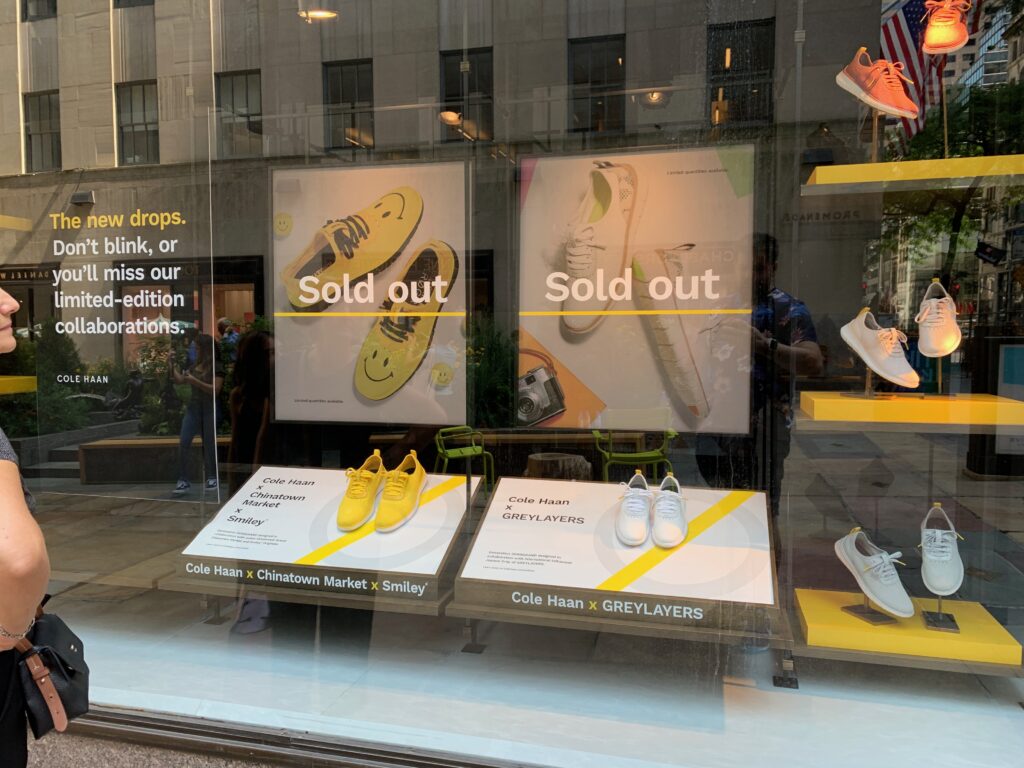This image is via Cole Haan and their ‘sold out’ display in the store near the Rockefeller Centre, New York (no less) which ends up raising a very interesting point on scarcity in retail.
I know there is a whole different world of people who track window displays, fast fashion, trend spotting and the like within the wider ‘apparel world’. A confusing and at times, near frightening world which must be one of the most cutthroat business areas, perhaps ever known to man.
One week you’re in fashion and the next week, it’s 50% off with the traders in the middle of shopping centres, or malls, quickly trying to get shut of their overstock of the former fashion product that was all the rage, a matter of weeks ago.
There are numerous examples of trends dying out of course; whilst not directly fashion related, anyone with kids can remember Loom bands, Fidget spinners and going back further to your own youth, what about POGS too!
Their display is strong and eye catching in terms of highlighting the product itself; alongside both the benefits and the brand in fell swoop.
Latterly (to me) the window itself is used to highlight “limited edition” – driving urgency to purchase and using scarcity for good. A good example of a multi depth based message.
Yet saying “Sold out” so boldly, in a window display is not good news for a retailer of any description. Akin to a restaurant saying “the fish is bad” or “we do have a pest problem” on their window.
But it does exude confidence. There’s no shame. Customers think “I want to do business here”.
Confidence is a great look for any brand.
All too often we see brands and more specifically, retailers of food, that are terrified, safety first retailing and merely celebrating a goalless draw (in retail terms).
Running the least worst stores…

Scarcity for good?
We are seeing more and more of scarcity being used as a tactic to grow interest and demand for products in the new ‘social commerce’ world. Especially on Insta!
If we look at any number of the various food producers on there, they appear to be reversing the trend that many food suppliers face and being able to generate excitement for their ‘store opening’ each week with the clear message of ‘when it’s gone, it’s gone.’
Their fans know this. It builds momentum as the social posts typically highlight their production work, building anticipation further.
With so many of them using Instagram to trade their wares and build anticipation, afterwards, some producers will announce their ‘sell out was in 12 minutes’.
Want that Fudge (Fudge producer, obvs) have 54,000 followers and have been featured in Tatler, and Vogue. They’ve also moved production premises twice already.
Blimey. Scarcity works!
It’s the reverse of what we know.
Scarcity done well is a beautiful model.
They’re able to flip the world of food production on its head entirely, with businesses armed with knowledge they have a brilliant product and a captive audience of fans and advocates too.
The producer is able to dictate how much they’re going to make and when and where it will be available too.
Exclusively, You can’t get this anywhere else.
This is directly oppositional to the usual ‘customer calls the shots’ model. Make as much as you can, blindly, and hope for the best (with all the costs that go with it). Clearance and markdown too.
A bad model.
Anticipation through socials
As producers harness their fans and drive brand awareness on Insta by offering a great product (this is of course, the start and end of it, you’re nowhere without a great product).
They make as much as they can with the aim of selling out. This generates anticipation across the week with their loyal band of fans seeing stories on Insta, new flavours, exclusives, a limited menu, competitions etc.
They all must log on at 8pm Sunday (or whenever their time is) to the website and try to buy.
Or they miss out for another week.
Driving innovation and experimentation
This enables innovation with collaborations all the rage, often these are between food producers on Instagram themselves. Further heightening the feeling of scarcity and near unique nature of product as these products are not sold anywhere else.
You have to be good to operate like this however, and the risk with one window opening is “newness” is key.
A limited menu means you have to get it right, there’s no range of 25 to work within.
For food retail, and indeed wider retail. Scarcity remains a bad word. Selling out because it’s popular is bad, even on lines that are produced in store. There is an expectation that everything will be available, all the time.
Which of course drives waste and doesn’t align with sales, which means forecasts are reduced across the board and that drives availability downwards because the retailer is hedging bets.
Scarcity better than ‘always on / unlimited’
Not the “loss leader” which just winds customers up. Something like ’20p’ loaves of Bread advertised in the national press, but each store is delivered one case which the staff all purchase, leaving nothing for customers.
That just drives negative brand sentiment and isn’t trustworthy. To get to a place where the Instagram boys and girls are; you have to have a great product, be relentless on socials and drive anticipation and awareness.
It’s a reminder that size and scale is good for the economies of scale, the costs become lower but it makes it harder to deliver on innovation and true scarcity.
Scarcity is still a bad word in retail, yet if you asked a tradesman to do a decent sized job and he offered to come tomorrow.
You wouldn’t book him.
Why?
Because anyone good is booked out for months in advance……
That’s scarcity, for good.